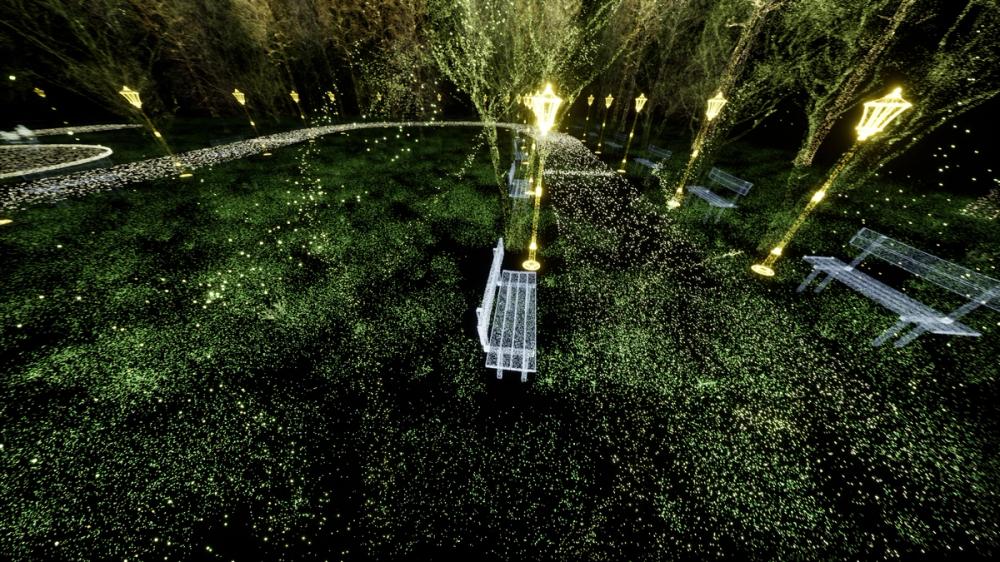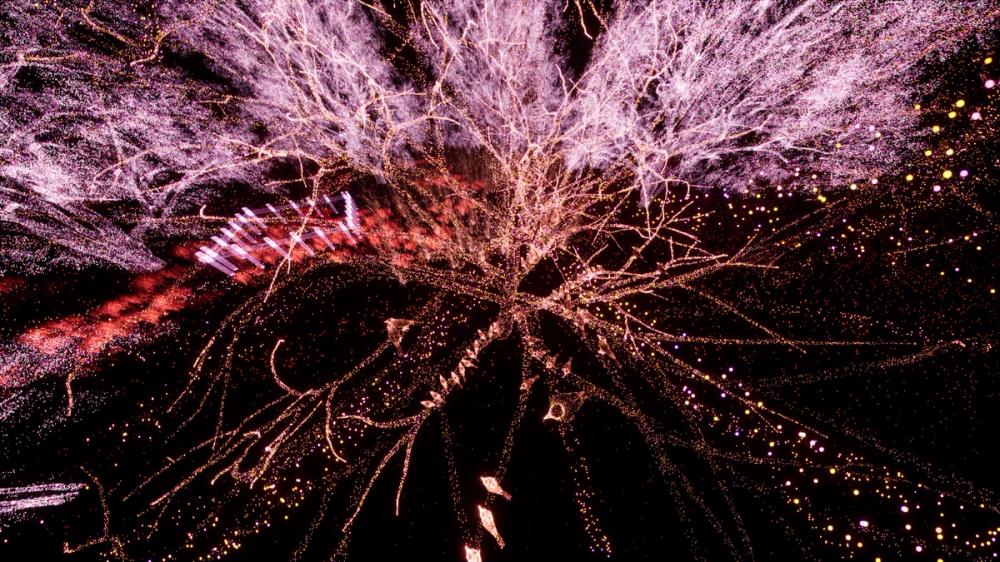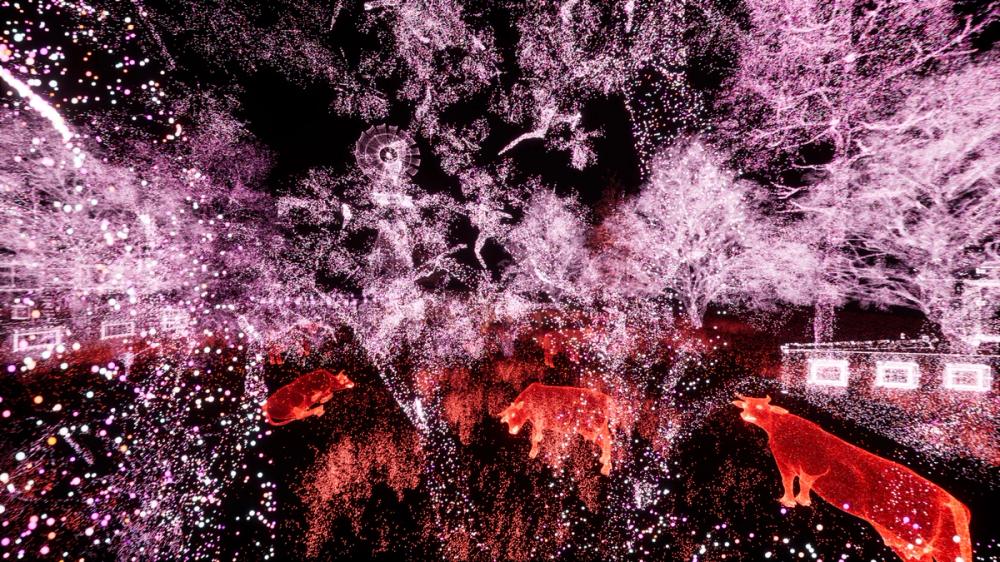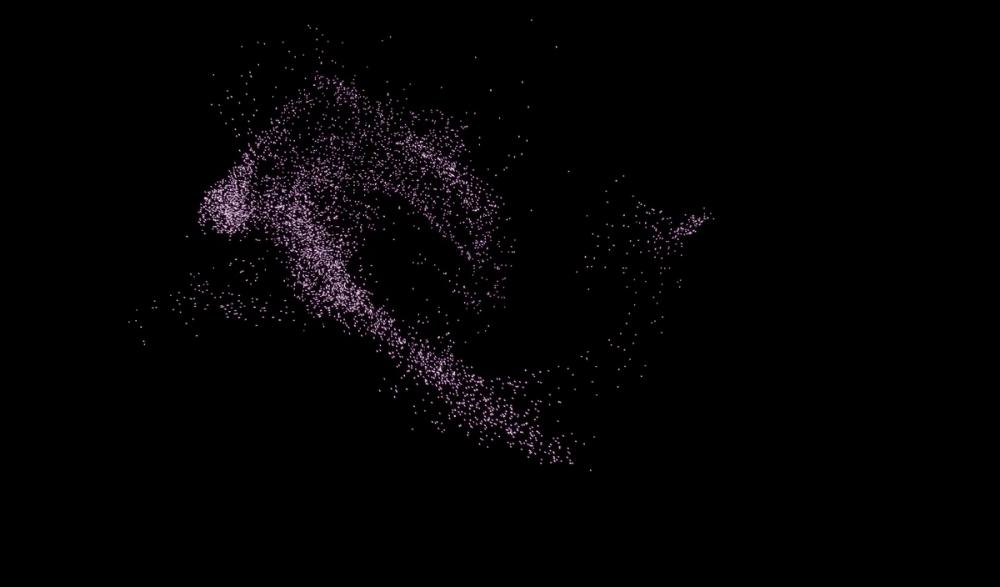We are responsible for shaping the conditions in which more-than-human life can flourish. This is an effort that asks us to listen, imagine, and design in ways that honour other beings.
Our journey toward creating Will We Disappear in the Cover of the Sky? (2024) began with a simple question: could we encourage the flourishing of starlings by translating more-than-human perspectives to humans through immersive technologies?

Our fascination began with birds, their songs, their intelligence, and their ability to adapt to shifting environments. We became especially drawn to the starling, a species whose dazzling murmurations stir awe and wonder. While they are considered an invasive species in the United States, they are native to the United Kingdom and are experiencing a significant decrease in their population. According to RSPB’s Big Garden Birdwatch, the average count of European Starlings in the UK has declined by 82% since 1979.
Starlings are remarkably complex beings. They have tetrachromatic vision, which means their eyes have four types of colour receptors, unlike humans, who have only three. This extra receptor allows them to see ultraviolet light, enabling them to perceive a spectrum of colours far beyond human capability. These highly social birds form large coordinated flocks called murmurations that move in synchronised patterns. This complex group behaviour is a showcase of their astonishing collective intelligence. Starlings are also excellent mimics and can imitate sounds from their environment, including other bird calls and human noises. Their vocal abilities even inspired Mozart!

Yet despite their richness, their decline is often overlooked. We wondered — could we tell a story from their perspective and bring them closer within ecological narratives? This question became the heart of Will We Disappear in the Cover of the Sky?
Our research drew from scientific studies and books such as In A Flight of Starlings by Giorgio Parisi, which draws parallels between the flocking patterns of starlings and atomic structures. An Immense World by Ed Yong offers a window into the sensory experience of animals, which remains largely unfathomable to humans. We were deeply inspired by the concept of umwelt, the specific way an organism experiences its unique perceptual world. Donna Haraway’s Staying with the Trouble advocates for a world of multispecies flourishing, an idea that many forms of life, including that of humans, other animals, plants and organisms, can thrive together. This perspective drew our attention to the deep interconnectedness of all species and challenged human-centred ways of thinking.
Jonathan Livingston Seagull by Richard Bach is another essential book that served as an inspiration, as its descriptive storytelling brings a bird’s experience to life in rich detail. The Seagull’s story of self-discovery and its pursuit of freedom influenced us to craft a narrative told from the bird’s perspective. Through speculative storytelling and digital media, we explored how shifting our sensory perspective could evoke biophilia: a deep, empathetic connection to other forms of life.
We then consulted researchers from the Royal Society for the Protection of Birds (RSPB) and the British Trust for Ornithology, whose insights deepened our understanding of the causes behind the starling’s decline.

Our narrative focuses on two primary issues: First, how intensified cattle farming disrupts starling foraging patterns. Though not talked about in the film, it is essential to note that this causes huge distress to cows as well, another more-than-human species whose lives become marked by confinement and pain, and are artificially shortened. Second, how urban landscapes, particularly glass buildings, create barriers to wayfinding. Birds often cannot distinguish reflective surfaces from open sky, turning architecture into invisible hazards.
The storytelling is guided primarily by visuals, sound and on-screen text. We deliberately chose not to use a voiceover, as we wanted to avoid anthropomorphising the starling’s perspective. A human voice could unintentionally impose human characteristics onto a non-human subject, which would undermine the project’s intention to explore a more-than-human perspective. The absence of voice also creates space to imagine and encourages a more open-ended engagement.

The film’s particle system became a visual metaphor for murmurations, an elemental dance embodying the intelligence of natural systems. Shifting colours and densely layered particle effects evoke the starling’s tetrachromatic vision, offering a poetic glimpse into ways of seeing beyond human perception.
Ultimately, the film reflects on the starling’s sensory world, its disorientation, and the rapidly changing landscapes it inhabits — it offers an empathetic encounter rather than a simulation.
Will We Disappear in the Cover of the Sky? does not just ask what is being lost in the Anthropocene. It asks how our ways of knowing, storytelling, and sensing might evolve in response.
We hope our film reaches infrastructure policymakers, agricultural practitioners, home gardeners, local councils and residents of the UK to inspire action and protect these vital species.
Film Summary
Will We Disappear in the Cover of the Sky? (2024) is an immersive experimental film that invites the visitor to traverse through different landscapes from an urban park to the higher altitudes of open skies. A more-than-human perspective emerges as a starling narrates, via subtitles, an account of the challenges brought about by rapidly growing human activities. According to RSPB’s Big Garden Birdwatch, the average count of starlings in the UK has decreased by 82% since 1979. We hope to inspire action to protect these vital species.
Description for people with visual impairments and other relevant access needs
The entire film is composed of particles that shift and flow to form landscapes, environmental elements and other critters. These particles, like moving points of light, change colour depending on the scene. Together, they form impressions of three key landscapes: a park, a farm, and a city. Text-based narration appears on screen, unfolding gradually in sync with the immersive sound design.
Scene 1 Description
The story begins in an urban park, where the starling and its flock have made a temporary home. But food is scarce. Trimmed grass and chemically treated soil leave little nourishment behind. Driven by hunger, the bird flies toward the countryside in search of food. The urban park is represented by flickers of green for grass and trees, and more orderly particle patterns to reflect the manicured nature of public parks.
On-screen text
“I see it clearly now
As crisp as the morning light
I am living with voices you might not hear
These new friends
We met under the canopies of a giant tree
I hope this time
They stay with me
We eat so we can fly
But there’s not enough here
So we travel to the countryside”
Scene 2 Description
At the farmland, the starling encounters new challenges. Intensive agriculture, cattle farming and the widespread use of insecticides have left the land depleted with few insects to eat, and the starling struggles to find food in an environment that once supported it. Red and pink tones are used in the farm scene to evoke the global impact of harmful farming practices.
On-screen text
“In these open meadows
We split and divide
Some look for food so look for foe
Field to field
Side to side
Here I’m not the only critter
The growing grass
It keeps them fed
Our food lies under this bed
If the Earth was undisturbed
We could grab enough for all”
Scene 3 Description
As it returns to the city, the journey becomes dangerous. Glass buildings reflect the sky and surrounding trees, confusing the bird’s navigation. Unable to distinguish between reflection and open air, it crashes into windows, a fate shared by many birds trying to survive in urban spaces. Blue hues represent the open sky and the cityscape.
On-screen text
“These glass panes to me
They are bodies of water
Where you see structure
I just see the sky”
Scene 4 Description
In the final scene, a murmuration of particles swirls across the screen, evoking the starlings' iconic collective flight. In this moment of motion and reflection, the bird questions whether there is still hope for the future.
On-screen text
“So then
Does food disappear?
Does home disappear?
Then what appears instead?
What happens when we’re flying so high?
Will we disappear in the cover of the sky?”
More Reads
Film
Solar Power and Peaches
Keep readingThe Solés have farmed peaches in Alcarràs for generations, but when their landlord wants to harness the profits of solar power, the family see their lands and orchards change forever. Kitty Grady reviews Carla Simón’s sensitive and timely exploration of a green revolution that is anything but sustainable. Edited by Eleanor Warr.
By Kitty GradyKeep readingThe matter that makes us will be here long after we are gone, but what kind of mark will we leave? In this IFLA! classic, from our Regeneration Issue, Phoebe Thomson explores deathscapes – 'landscapes of death' – and the legacies our bodies leave behind, from British cemeteries to Parsi Towers of Silence. She wonders whether a regenerative approach to handling death can breathe new life into old spaces. Illustrated by our very own Matthew Lewis.
Keep reading >
Landscapes
Death, Landscape, and the Environment
By Phoebe Thomson(Article)Landscapes
Death, Landscape, and the Environment
Keep readingThe matter that makes us will be here long after we are gone, but what kind of mark will we leave? In this IFLA! classic, from our Regeneration Issue, Phoebe Thomson explores deathscapes – 'landscapes of death' – and the legacies our bodies leave behind, from British cemeteries to Parsi Towers of Silence. She wonders whether a regenerative approach to handling death can breathe new life into old spaces. Illustrated by our very own Matthew Lewis.
By Phoebe ThomsonKeep readingArchitecture
A Call for Ancestral Futurism: decolonizing and decarbonizing architecture
Keep readingIn Jamaica, the ‘Isle of Wood and Water’, locals find themselves caught between traditional and modernist values, especially when it comes to building new homes. Teshome Douglas-Campbell explores this phenomenon through the lens of ‘Ancestral Futurism’, finding a new way forward that takes inspiration from architects and architecture from across the global South.
By Teshome Douglas-CampbellKeep reading- Read more
